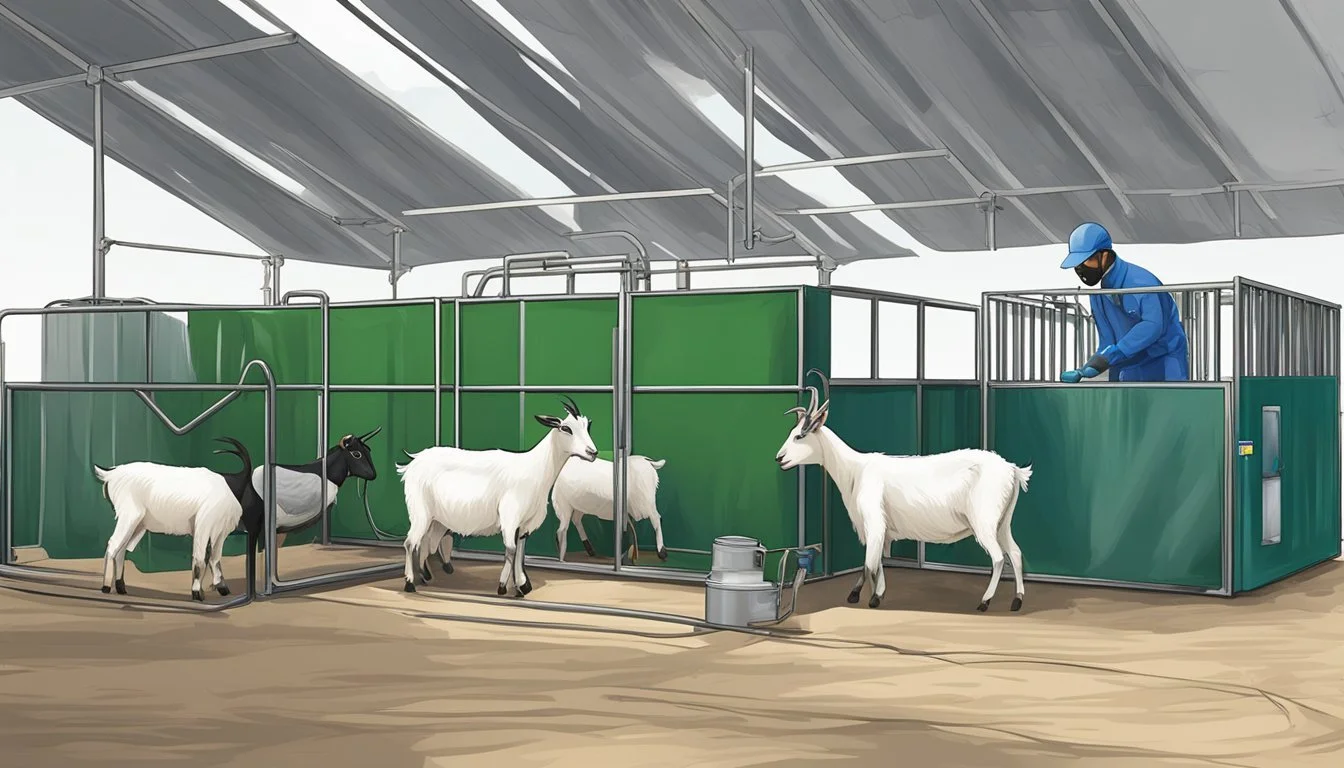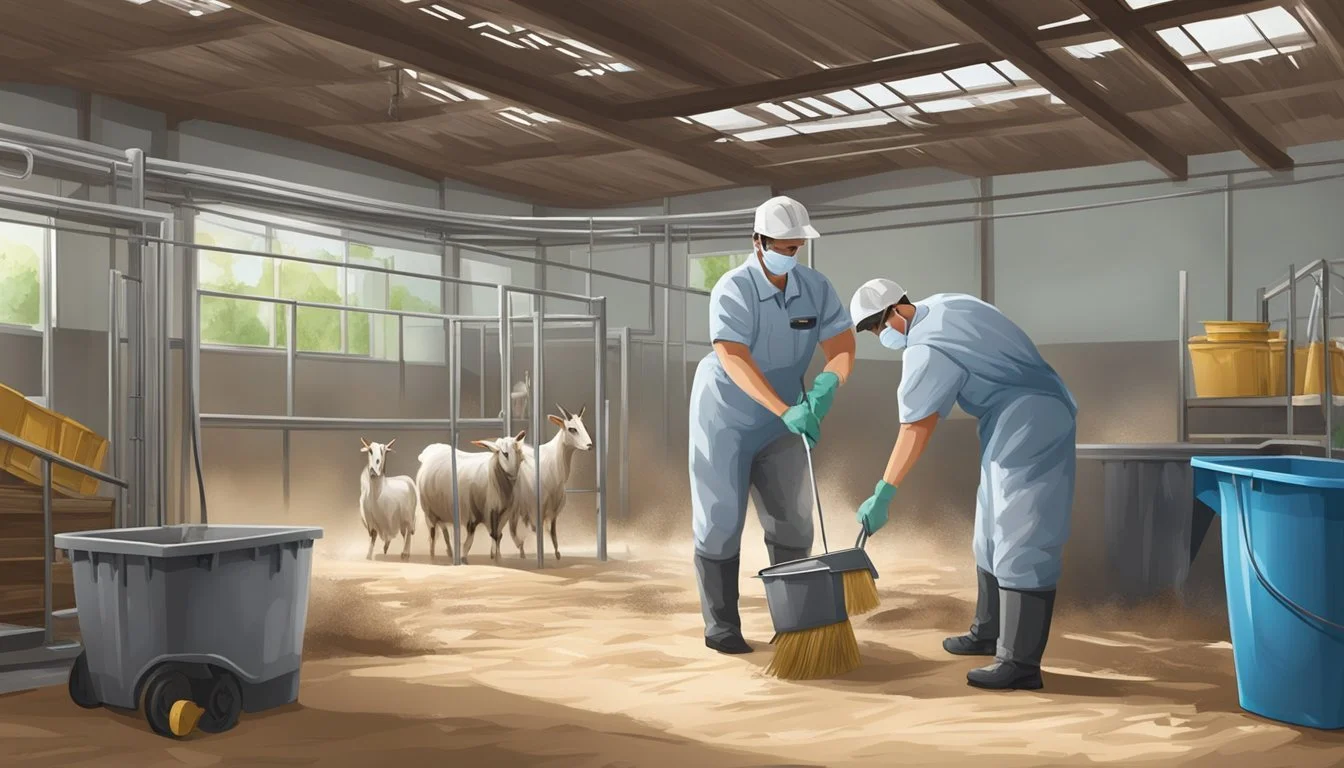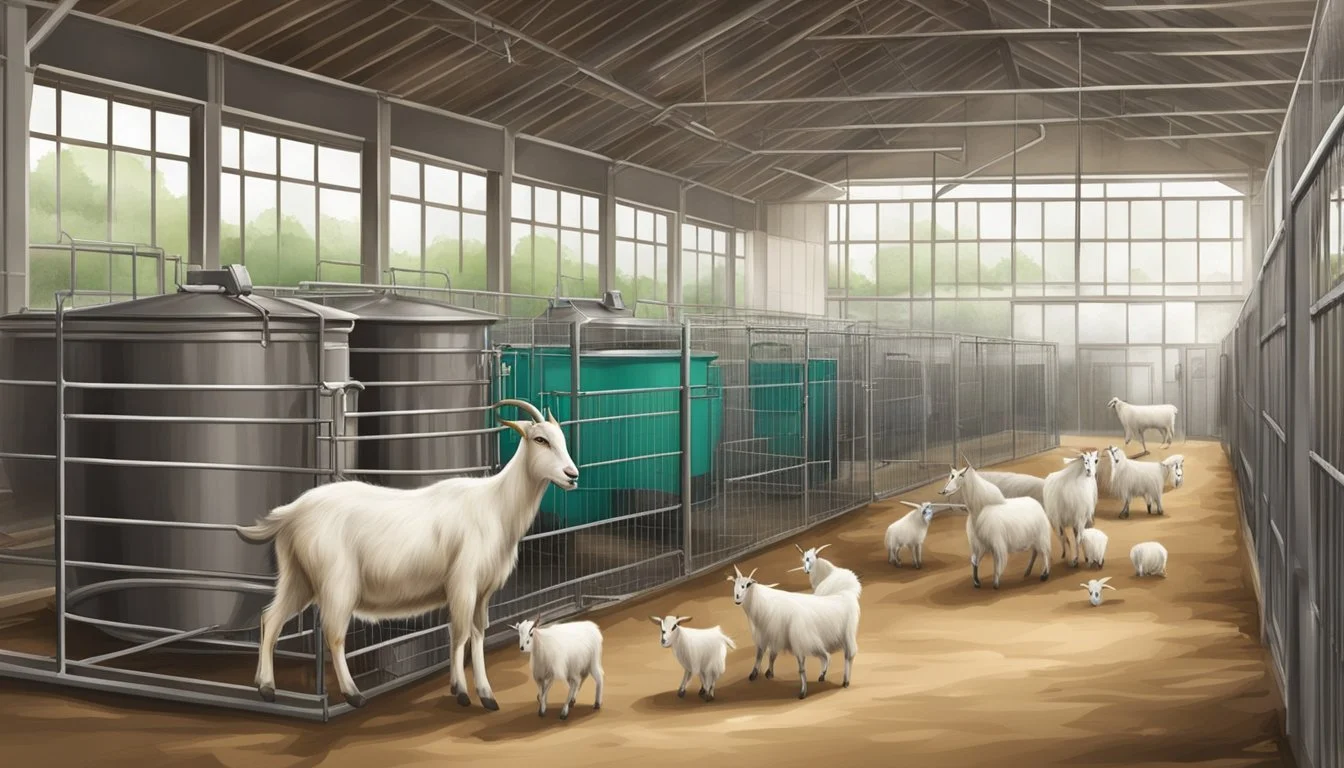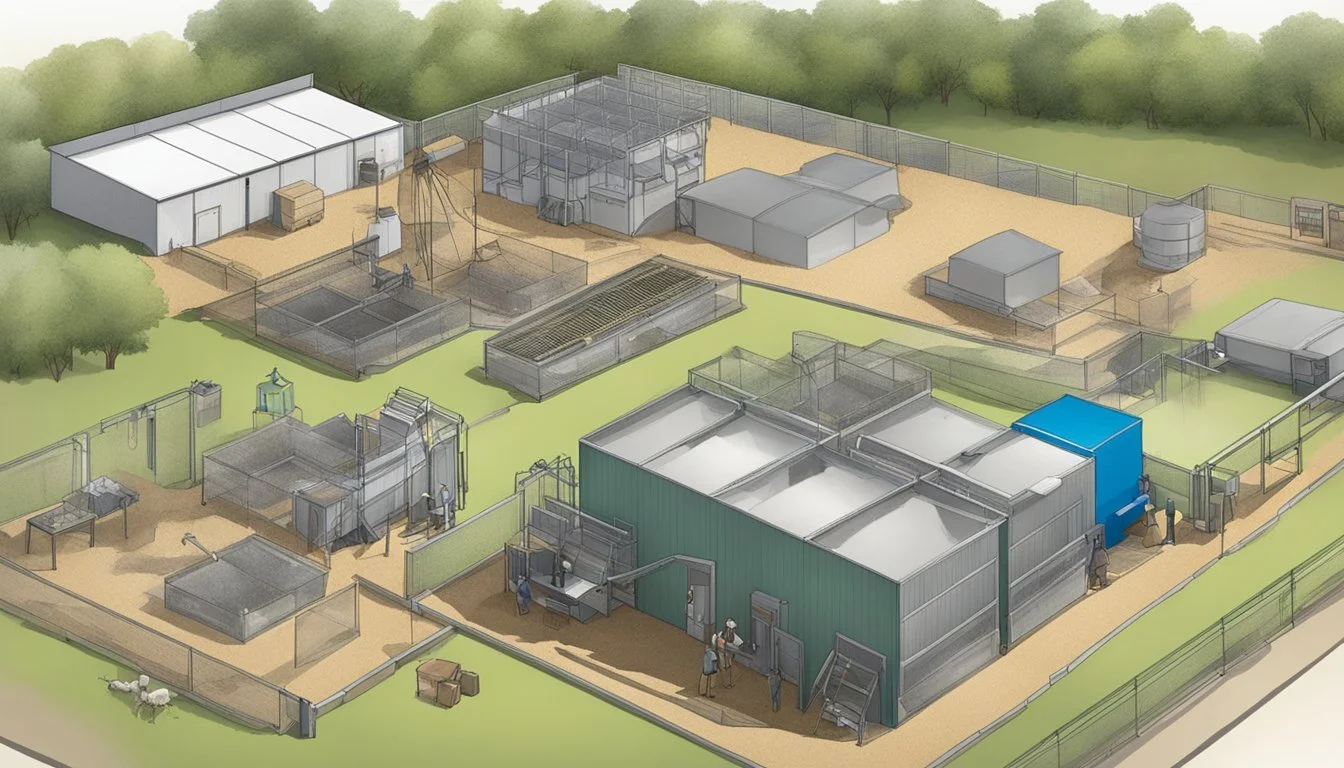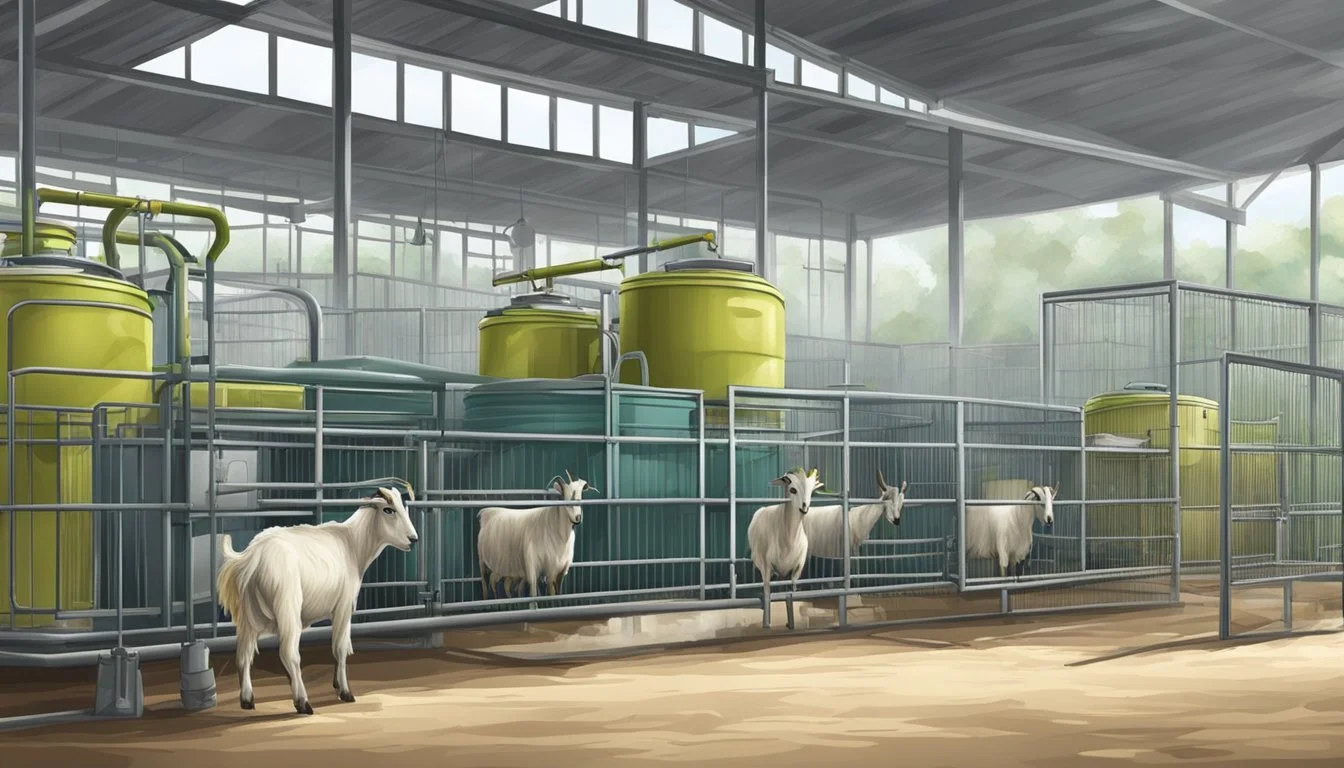How do I Properly Disinfect My Goat Pens and Equipment
A Step-by-Step Guide
Maintaining clean and disinfected goat pens is crucial for the health and well-being of goats. Disinfection helps prevent the spread of diseases and creates a sanitary environment for the animals. Proper cleaning routines involve the removal of soiled bedding, droppings, and other waste, followed by the application of disinfectants that are safe for use around livestock. It’s essential to choose cleaning agents that are effective against common pathogens found in goat pens, including bacteria, viruses, and parasites.
When disinfecting pens and equipment, one must pay attention to detail to ensure all surfaces are thoroughly treated. Tools like shovels, brooms, and scrapers are commonly used to clean out waste before the disinfection process begins. It's important that those responsible for the care and management of goats understand the best practices for disinfection, including the preparation, application, and proper handling of cleaning products.
A systematic approach to cleaning not only results in a healthier environment for the goats but also helps in maintaining their productivity and the overall hygiene of the farm. Despite the varying designs and sizes of goat pens, the principles of effective cleaning and disinfection remain constant. Thorough cleaning of feeding pens, for example, is necessary to prevent the spread of disease. This involves regular disinfection of feeders and water troughs, which are critical contact points for goats.
Understanding Goat Housing Needs
Goats require a secure and comfortable environment to thrive, which means that their pens and shelters need to be carefully designed. Size is an important consideration; each adult goat needs about 1.5 to 2 square meters of space, with 1 square meter per kid to promote healthy growth and movement.
The climate heavily influences the type of housing needed. In colder regions, goats need a barn or shelter that provides warmth and protection from the elements. Conversely, in warmer climates, shelters should provide ample shade and be constructed to maximize airflow.
Ventilation cannot be overlooked as it ensures the health and well-being of goat herds by preventing the buildup of moisture and harmful gases. Well-designed ventilation systems help control temperature and humidity within the pen.
The flooring of a goat pen should promote good sanitation. Properly draining floors made from slatted wood or another suitable material helps to keep the area dry and reduces the spread of parasites and diseases.
It is imperative that goat shelters are secure. Sturdy fences and enclosures protect goats from predators and prevent any escapees while also delineating spaces for different uses, such as feeding or isolation areas for sick animals.
Lastly, the design should provide easy access for maintenance tasks. This includes regularly cleaning the space and disinfecting equipment, ensuring a healthy environment for the goats to reside.
Size: 1.5-2 m² per adult goat, 1 m² per kid
Climate: Warm shelters for cold climates; ventilated for hot ones
Ventilation: Essential for temperature and humidity control
Flooring: Should be dry, well-drained
Security: Sturdy enclosures to protect from predators
Fundamentals of Pen Maintenance
Maintaining goat pens is pivotal for the health and well-being of the animals. A proper routine maintenance plan includes regular clean up and sanitization procedures to prevent illness and promote a hygienic environment. Health checks, vaccinations, and hoof trimming are essential components of a complete care regimen for goats.
Daily Tasks:
Remove visible manure and soiled bedding.
Check water and feed troughs for cleanliness.
Weekly to Monthly Tasks:
Replace bedding to maintain a dry and comfortable pen.
Perform a thorough inspection of all areas for hazards.
Semi-Annual Actions:
Conduct comprehensive health examinations.
Schedule hoof trimming and vaccinations as required.
The materials for pen maintenance should be chosen with absorbency and ease of cleaning in mind; straw or pine bedding is often recommended. Using tools like shovels, wheelbarrows, and brooms, caretakers can effectively remove waste and debris. In addition, periodic application of limewash can serve as a natural disinfectant, helping to control odors and reduce the presence of harmful bacteria.
Owner's must remain vigilant, addressing any signs of wear or damage to the pen promptly. This might involve fixing fencing, gates, or shelters to ensure safety and security.
Through consistent regular maintenance and attention to detail, they can curate a clean and disease-free habitat for their goats, which, in turn, can lead to a more productive and less stressful environment for both the owner and their herd.
Cleaning and Disinfecting Protocols
Proper sanitization of goat pens is essential for maintaining animal health and farm hygiene. The following protocols cover the full spectrum of cleaning and disinfecting, ensuring that all surfaces and equipment are appropriately treated to minimize the risk of disease.
Assessing the Area
Before cleaning, it's important to assess the pen's condition. They should look for signs of ammonia build-up from urine, which can be detrimental to both goat and human health. It is also crucial to identify any broken equipment or areas that require special attention due to excessive waste.
Removing Waste and Bedding
One must begin with the removal of all soiled bedding, including straw, wood shavings, or pine shavings. This should be done wearing gloves to minimize contact with contaminants. After waste removal, they should thoroughly sweep and rake out any remaining debris to prepare the surfaces for the application of disinfectants.
Application of Disinfectants
Following cleaning, apply an animal-safe disinfectant generously over all surfaces. Disinfectants must be used according to the manufacturer's instructions to ensure effectiveness. The use of lime can also help neutralize odors and manage urine and waste breakdown, but it must be used with care to prevent irritation to the goats.
Drying and Monitoring
Once disinfectants have been applied, the area should be allowed to air dry completely. Proper ventilation is key during this stage to evaporate any residual moisture and chemical fumes. Monitoring the pen for dryness ensures it is safe and comfortable for the goats to return.
Scheduled Maintenance
Regular maintenance is essential for long-term cleanliness. Establish a routine schedule for deep cleanings, which includes disinfecting all equipment and supplies. This prevents the build-up of harmful pathogens and maintains a sanitary environment for the animals.
By following these protocols, farmers and caregivers can maintain a sanitary living space for their goats, contributing to the overall wellbeing of the herd.
Pen Design and Layout
The layout and design of a goat pen are critical for efficient maintenance and disinfection. Thoughtful design can mitigate the workload involved in cleaning and minimize the risk of disease spread among your goats.
Optimal Pen Configuration
An effective goat pen layout incorporates adequate space for the animals to move, rest, and feed while allowing easy access for cleaning and maintenance. East-west orientation of the pen maximizes sunlight exposure, which can help naturally disinfect the pen. Dividing the space into separate areas or partitions can be beneficial for goats with different needs, such as isolating sick animals.
Fencing and Security
Robust fencing is essential not only to keep goats contained but also to protect them from predators. The fence height should be proportionate to the breed of goat; more agile breeds may require higher fences. Security is enhanced by installing sturdy gates that offer easy access for handlers but prevent goats from escaping.
Feeding and Watering Solutions
Equipping the pen with strategically placed feeders and waterers can facilitate efficient feeding routines and simplify cleaning tasks. They should be designed for easy access by the goats but configured to minimize waste and contamination, which is crucial for a healthy goat environment. Regular cleaning and disinfection of feeders and water troughs help prevent disease spread.
Health and Safety Considerations
Proper disinfection of goat pens and equipment is crucial in maintaining goat health and preventing the spread of diseases and parasites. Safety measures must also be taken to protect goats from potential predators.
Disease Prevention
Regular disinfection is key to preventing bacteria and disease in goat habitats. Pen surfaces should be treated with appropriate disinfectants that are effective yet safe for goats. All feeding troughs and water containers should be regularly disinfected to minimize the risk of microbial contamination that can lead to health issues.
Parasite Control
Controlling parasites requires a two-pronged approach: maintaining a clean environment and regular health check-ups. Bedding should be kept dry and replaced frequently to deter parasite proliferation. Use of a lime wash can help in sanitizing the goat pen, creating an environment less hospitable to parasite eggs and larvae.
Safety from Predators
Ensuring the physical safety of goats from predators like coyotes and bobcats involves structurally sound and reinforced fencing. The use of barbed wire at the top can deter climbing predators, and bird netting over enclosures can prevent attacks from aerial threats. Regular inspections of the enclosure are necessary to ensure there are no gaps or weak points through which predators could gain access.
Equipment and Supplies Management
Proper management of equipment and supplies is critical for maintaining a sanitized goat pen. Cleanliness should be a priority, as dirty equipment can harbor pathogens that are harmful to livestock. Regularly disinfect items such as feeders and water troughs to prevent the spread of diseases.
Feeders: Clean daily and disinfect weekly.
Water Troughs: Empty, scrub, and refill daily.
Stall Freshener: Apply to neutralize odors and absorb moisture.
Lime Wash: Use periodically to disinfect walls and floors.
For areas like kidding pens, a more frequent cleaning schedule is vital. After each use, one should remove all bedding, cleanse the space thoroughly, and apply stall fresheners or lime powder to reduce moisture and maintain a healthy environment for newborns.
It’s recommended to keep a stock of essential cleaning supplies such as brooms, shovels, and disinfectants to ensure that the physical cleaning of pens can be undertaken efficiently and effectively. The correct usage of supplies is also important; for example, lime wash must be prepared and applied according to its specific instructions to achieve its disinfectant properties.
Furthermore, creating a maintenance routine for all facilities is beneficial. This involves regular checks and repairs to avoid injuries to the goats or contamination due to damaged equipment. It's essential that all caretakers are trained in these protocols to sustain a high standard of care. Keeping equipment and supplies well-managed assures a healthier environment for goats, which is crucial for their well-being and productivity.
Kidding Season Specifics
During kidding season, the disinfection of goat pens and equipment becomes even more critical to ensure the health and safety of both the does and newborn kids. A strict regimen should be followed to promote a sanitary environment.
Daily Maintenance:
Remove any soiled bedding and waste promptly.
Disinfect water buckets with a bleach solution (one part bleach to ten parts water), then rinse thoroughly.
Replace with fresh hay frequently to maintain a dry lying area.
Kidding Pens Cleanliness:
After each birth, conduct a thorough clean-out of the kidding pens.
Use disinfectants safe for animals, such as phenolics, on surfaces to kill pathogens.
Post-Kidding Equipment Care:
Disinfect all tools, including gloves, ropes, and bottles, used during the birthing process.
Soak equipment in a proper disinfecting solution and ensure they are dried before storage or reuse.
Scheduled Sanitization:
Schedule deep cleaning once a week where all surfaces, feed troughs, and walls are washed and disinfected.
By maintaining a high level of cleanliness, farmers can reduce the risk of disease and create a conducive environment for kidding and the subsequent health of the herd. Proper disinfection routines during kidding season are essential for the successful rearing of goats.
Refer to preparing your pens for specifics on setting up a birthing pen, which includes ensuring a clean water source and stable hay feeder setup.
Alternative Bedding Options
When managing goat pens, selecting the right bedding is critical for the health and comfort of the goats. Here are several alternative bedding options:
Straw: A common choice, straw is affordable and provides good insulation against cold weather. However, it needs to be changed regularly as it doesn't absorb moisture well.
Wood Shavings: These are highly absorbent and can keep a pen drier, but cost more than straw. Pine shavings are particularly popular due to their pleasant scent and moisture-wicking properties, though one should ensure the goats are not eating them as they could cause health issues.
Sawdust: A more economical bedding option, sawdust is easy to handle and has excellent absorbency. It can be sourced from sawmills; sometimes at a very low cost or even for free. Its fine particles make it easy to clean and effective in controlling odors.
Regarding the bedding management approach, the deep-litter method involves layering bedding material without removing the contaminated layers immediately. This technique allows the material to compost over time, providing extra warmth. On the other hand, the non-deep litter method requires regular removal of all soiled bedding, requiring more frequent maintenance but ensuring a cleaner environment. Each method has its benefits, and goat keepers must choose based on their specific circumstances and goat needs.
Improving Livestock Welfare
Proper disinfection of goat pens and equipment is crucial for maintaining the welfare of livestock. It is the responsibility of the farmer to ensure that the animals are raised in a clean and sanitary environment. Not only does this practice help in preventing the spread of diseases, but it also promotes a healthy growing space conducive to goat breeding and raising goats.
Shelter and Goat Living Space: Regular cleaning and maintenance of shelters are imperative. One must remove all manure and soiled bedding from the pens, followed by thorough disinfection of walls and floors to create a clean environment for birthing. This process minimizes the risk of diseases such as Johne's disease, calf scours, and mastitis.
Disinfection of Equipment:
Use appropriate disinfectants for equipment.
Ensure all tools are cleaned post-use.
Adopt a regular cleaning schedule.
Supplements and feeding equipment should be kept free of contaminants to prevent the ingestion of harmful bacteria. Fresh, clean water must be available at all times, echoing the recommendations for livestock welfare.
Biosecurity Measures: Implement biosecurity protocols such as:
Footbaths at entry/exit points.
Isolation of new or sick animals.
Regular hand washing stations.
Engagement in these practices exemplifies a commitment to animal welfare and showcases a knowledgeable approach to goat care. It is essential for the well-being of both the livestock and the individuals who handle them on a day-to-day basis.
Storage and Waste Management
Properly managing waste and storing feed and bedding are critical components of maintaining a hygienic environment in goat pens. Efficient waste management reduces the risk of disease, while proper storage solutions enhance the longevity and quality of feed and bedding.
Compost and Manure Handling
Goat manure is beneficial for compost, increasing the water holding capacity of the soil. To create valuable compost, one should combine goat poop with carbon-rich materials such as straw or leaves, balancing nitrogen and carbon elements. The compost should be regularly turned to ensure proper aeration and decomposition, transforming waste into a resource for soil enhancement. Regular removal of manure from the pen is essential, and utilizing tools like shovels and specialized machinery can streamline this process.
Storage Solutions for Feed and Bedding
Feed should be kept in sealed containers or bins that shield it from moisture, pests, and contamination. They ensure that the nutritional quality of the feed remains intact over time. Hay feeders limit waste, keeping hay off the ground and accessible to goats. For bedding, moisture-resistant storage solutions are imperative. Utilizing limewash can maintain the cleanliness and antimicrobial quality of the bedding area. Bedding should be stored in a dry, ventilated space away from direct contact with the ground to prevent spoilage and mold growth.
Controlling External Factors
Proactive management of external elements is vital for the sanitation and well-being of goats within their pens. This includes thorough strategies for mitigating weather-related deterioration of goat pens and managing the risk of contamination through farm operations and visitations.
Weather Impact on Pen Maintenance
Climate plays a crucial role in the state of goat shelters. Excessive rainfall can lead to muddy conditions, which increase the risk of disease spread. To combat this, one should ensure proper drainage systems are in place. Conversely, hot climates demand shady areas and sufficient water to prevent heat stress in goats. Structures should be built to withstand local weather patterns, thereby reducing the need for frequent repairs that disrupt the environment and potentially introduce contaminants.
Impact of Farm Traffic and Visitors
Farm traffic and visitors can unintentionally introduce pathogens into barns and goat pens. To control this risk, farmers should establish a biosecurity protocol. This includes designated pathways for vehicles to minimize interaction with the goats' living spaces and providing disinfection stations for visitors to cleanse boots and hands before entering sensitive areas. Limiting access to only essential personnel and ensuring that clothing and equipment are disinfected when moving from pen to pen can significantly reduce the chance of cross-contamination.
Additional Considerations
Proper disinfection of goat pens and equipment is crucial, but it's important to consider the broader context of the farm environment. The interaction with other farm animals and the usage of pens for multiple purposes can significantly affect the disinfection process.
Interaction With Other Farm Animals
If goats cohabit with other herd animals such as sheep, disinfection protocols must account for the different health and safety requirements of each species. Products safe for goats may not be suitable for other livestock present. Regular health checks should be conducted to prevent cross-species disease transmission. For instance, Clostridium perfringens type D can affect both goats and sheep, necessitating careful disinfection to control its spread.
Multi-Purpose Pen Usage
Pens serving multiple roles -- like housing for raising goats and storage for farm equipment or crops -- should be disinfected with versatility in mind. A combination of uses demands that the disinfectants employed do not leave harmful residues that could contaminate crops or feed. For every piece of equipment, check the manufacturer's guidelines on the appropriate disinfectants to ensure safety without compromising the pen's multiple functions.
Frequently Asked Questions
In addressing the cleaning and maintenance of goat pens and equipment, goat owners often encounter specific challenges and look for best practices to ensure a healthy environment for their goats. Below are key insights into common issues and effective strategies.
Common Cleaning Challenges
One prevalent question is how to effectively tackle cleaning difficulties when maintaining a goat pen. Dealing with stubborn stains or disinfecting surfaces can be problematic, especially when access to certain areas of the pen is restricted. A frequent issue is the buildup of waste in corners or underneath feeders which requires regular attention. To prevent the spread of disease, it's critical that all surfaces the goats come into contact with are properly cleaned and sanitized. For instance, maintaining a clean watering area can prevent the buildup of harmful bacteria, as seen in goat waterers, where ensuring the water is fresh and troughs are clean encourages healthy drinking habits.
Best Practices for Pen Upkeep
To establish optimal conditions for different goat breeds, one must understand the best practices in pen maintenance. It's essential to provide sturdy fencing to secure the perimeter for the goats, which also facilitates easier cleaning routines. Regular cleaning is recommended with the use of adequate disinfectants, which are instrumental in keeping the environment safe and hygienic. The application of limewash has been noted to effectively clean and offer antibacterial properties, enhancing the pen's overall hygiene. Other maintenance routines should include checking the integrity of the fences and gates to ensure the goats remain safely within their designated area. Regular inspection and repair of any damaged areas will prevent potential escapes and reduce the chance of injury to the goats.
Final Thoughts and Summary
Maintaining a clean and disinfected environment is essential for the health and well-being of goats. Regular cleaning and disinfection of pens and equipment prevent the spread of diseases and create a pleasant living space for the goats.
Daily Maintenance: Remove visible soiling and waste. Spot-cleaning can be effective in managing the build-up of debris and odors.
Routine Disinfection: Incorporate a regular schedule that includes thorough cleaning followed by disinfection. Products such as limewash have antibacterial properties and are useful in goat pen maintenance.
Deep Litter Method: Consider the Deep Litter Method to save on daily labor while maintaining pen hygiene, though it requires periodic intensive cleanouts.
Equipment Care: Clean brushes, shovels, and other tools after every use. Disinfect them regularly to prevent disease transmission.
Disinfection is not just about cleanliness; it's also about ensuring that the goats have a safe and stress-free environment. Operators should use protective gear while cleaning and follow the manufacturer's instructions for all cleaning agents and disinfectants.
By adhering to these practices, one can assure that they are doing their utmost to support their goats' health and productivity. The goal is to establish a clean habitat that promotes the animal's health and a farmer's peace of mind.

